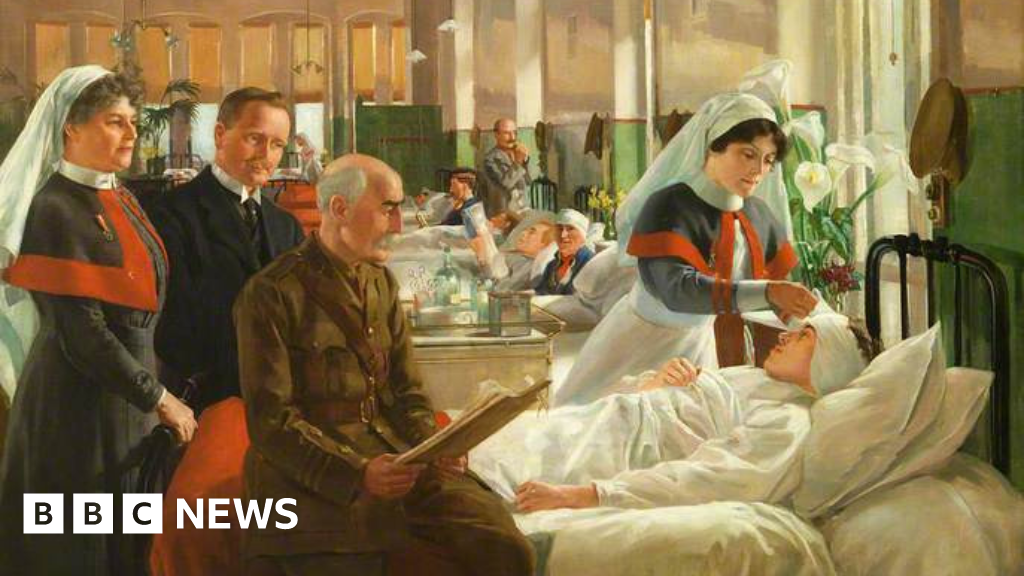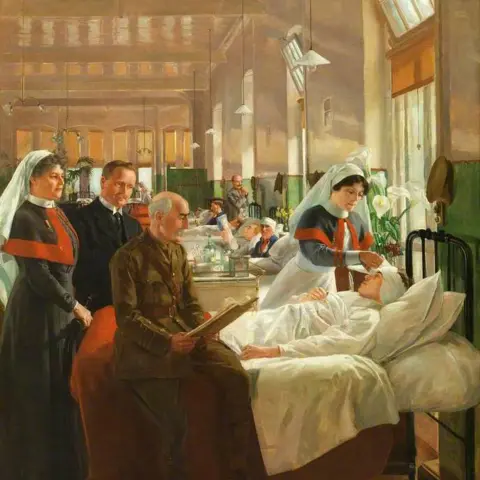 Cardiff and Vale University Health Board
Cardiff and Vale University Health Board
The 1916 oil painting hung at Cardiff Royal Infirmary for more than 80 years
In 1974, student nurse Pam Enani was having a bad day on the orthopaedic ward of Cardiff Royal Infirmary – retching at bed pans, and facing criticism from her matron for something she hadn’t done.
But a simple suggestion from one of her patients, would leave her stunned and prove a defining moment in her nursing career and life.
Mary Jones, in her 90s, asked if she was going on her break, adding: “If so, please would you pop down to the Mametz Wood Ward, and have a look at the painting down there?”
What she saw was the depiction of an injured soldier being treated – this not only begun a lifelong fascination with Barry-born artist Margaret Lindsey Williams, but later inspired a search to find what happened to her floor-to-ceiling painting when the Cardiff Royal Infirmary closed in 1999.
Thousands of patients and visitors would have walked past and seen painting The Care of Wounded Soldiers.
But what made it more special for Pam was the fact she was treating somebody depicted in it.
“When I came back I had to do a double-take…’is that you in the painting Mary?’,” asked Pam.
“She said yes, and that in her day the ward would have stunk of rotten flesh being treated with maggots, and she wouldn’t have put up with being bullied by her matron, as I was allowing mine to push me around.
“Well, that was me told.”
The floor to ceiling painting was unveiled in 1924, on the ward which went on to be named after the famous World War One battle of Mametz Wood.
It was where more than 4,000 Welsh troops were killed, and around 10,000 were injured.
The painting later hung in the main foyer of the Cardiff Royal Infirmary.
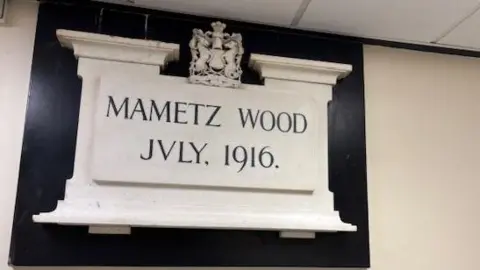 Pamela Enani
Pamela Enani
The Cardiff City War Ward was renamed Mametz Wood Ward in recognition of the 1916 battle
Pam went on to work in Canada and Saudi Arabia, as well as in the intensive care unit at the University Hospital of Wales, Cardiff, for more than 30 years.
Whilst she took the painting and Mary Jones’ message with her, throughout her career, she hadn’t really thought about it on a daily level, until she saw it in a TV documentary to mark the centenary of Mametz Wood in 2016.
“There it was, hanging on the wall of Robertson Hall at the Royal Military Academy at Sandhurst,” she said.
“I had to know how it had got there.”
Pam discovered how, after Cardiff Royal Infirmary was closed in 1999, the artwork had been cut out of its frame and rolled up, only to be stored in a dank chapel building on the site.
It was discovered by chance by a former nurse, Mary Reid, visiting the hospital for the last time before its proposed demolition in 2005.
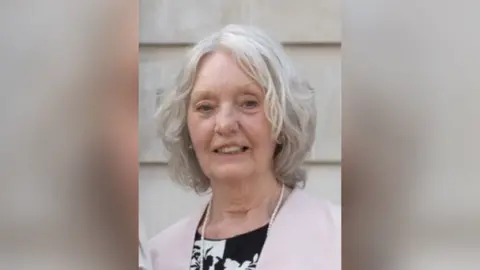 Pamela Enani
Pamela Enani
Pam Enani left the hospital in 1976 but never forgot the painting
An injunction was then granted against knocking the building down for redevelopment, as the original covenant stipulated that the site could only be used for the healthcare of Cardiff’s population.
From there the painting was loaned to Sandhurst, who raised £70,000 for its restoration.
But until Pam began her exhaustive research from government and NHS documents as well as local newspaper cuttings, Sandhurst had very little idea of what they had in their possession.
“When they received it, it was unrecognisable from the painting I knew, so no wonder it was hard to define, and even less surprising that it cost so much to restore,” she said.
“I got in touch with their curator, who gave me the story of how it had ended up with them, but he was desperate to find out anything more about the people it showed.”
Pam’s search discovered that it had been commissioned by coal and railway magnate Sir William James Thomas, who is depicted in the painting, standing next to the matron at the foot of the bed.
 Getty Images
Getty Images
The main building of the Cardiff Royal Infirmary was built and opened in 1883 and largely closed in 1999
Inheriting the Great Western Railway and the Ynyshir Standard Mines, Sir William sold off all his assets and sunk his fortune into improving the healthcare of Cardiff, establishing the first medical school in Wales.
Pam also learned that the others in the painting are.
These include matron Montgomery Wilson, who had served in a Boer War field hospital, Sister Mary Jones, who had been her patient in 1974, private BJ Davies, a Welsh soldier evacuated from the western front, and senior surgeon Lt-Col Philip Rees Griffiths.
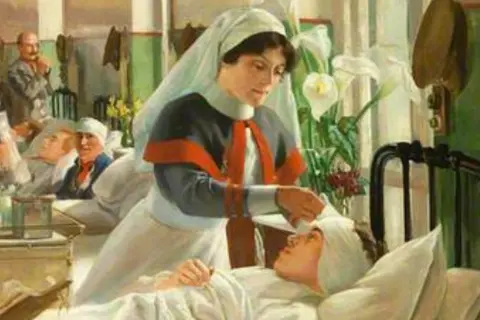 Cardiff and Vale University Health Board
Cardiff and Vale University Health Board
Sister Mary Jones, Pam’s patient in 1974, shown in the painting when much younger, is attending the wounded soldier
Margaret Lindsey Williams, 1888-1960, is more famous for her portrait works, which is perhaps why this group-scene had slipped out of memory.
Growing up in Barry, Vale of Glamorgan, she studied at the Cardiff Technical College where she won a gold medal.
She later attended Pelham School of Art, Kensington, and then the Royal Academy of Arts, where in 1906, she studied under the renowned portraitist John Singer Sargeant.
Williams was famed for her raucous and fun-filled parties with fellow artists and socialites, in her St John’s Wood home during the early 20th century.
She is best known as portraitist by royal appointment – painting Queen Elizabeth II on five occasions, and also Princess Anne and a very young King Charles, who is said to have turned up for his sitting wearing overalls and carrying paint brushes, as Williams had inspired him to become an artist too.
She ventured to the States, where she painted car pioneer Henry Ford, and President Warren Harding, who posed for her in the Oval Office.
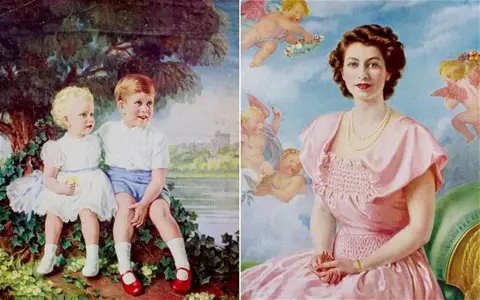 National Portrait Gallery
National Portrait Gallery
Mary Lindsey Williams is said to be the artist who has encouraged King Charles to paint to this day
One of her more avant-garde pieces, The Devil’s Daughter is said to have inspired Black Sabbath’s early albums, whilst on a more genteel musical note, she also painted Welsh compatriot Ivor Novello.
She died on 4 June 1960, just shy of her 72nd birthday.
Pam said: “She’s buried in Merthyr Dyfan Cemetery, Barry, and it’s only very recently that her grave has been marked with a headstone.
“It’s incredibly sad that her legacy – outside of her royal paintings – has been largely overlooked, but equally that the message she tried to convey about the futility of war has also gone by-the-by.”

